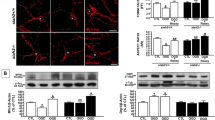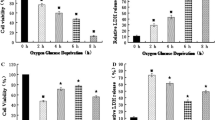Abstract
Phosphatidylinositol 3-kinase (PI3K) plays several important roles in neuronal survival. Activation of the pathway is essential for the neuroprotective mechanisms of materials that shield neuronal cells from many stressful conditions. However, there have been no reports to date about the effect of the direct activation of the pathway in hypoxic injury of neuronal cells. We investigated whether the direct activation of the PI3K pathway inhibits neuronal cell death induced by hypoxia. Primary cultured cortical neurons (PCCNs) were exposed to hypoxic conditions (less than 1 mol% O2) and/or treated with PI3K activator. Hypoxia reduced the viability of PCCNs in a time-dependent manner, but treatment with PI3K significantly restored viability in a concentration-dependent manner. Among the signaling proteins involved in the PI3K pathway, those associated with survival, including Akt and glycogen synthase kinase-3β, were decreased shortly after exposure to hypoxia and those associated with cell death, including BAX, apoptosis-induced factor, cytochrome c, caspase-9, caspase-3, and poly(ADP-ribose) polymerase (PARP), were increased. However, treatment with PI3K activator normalized the expression levels of those signaling proteins. PARP activity and levels of ATP and NAD+ altered by hypoxia were also normalized with direct PI3K activation. All these findings suggest that direct and early activation is important for protecting neuronal cells from hypoxic injury.






Similar content being viewed by others
References
Malhotra R, Lin Z, Vincenz C, Brosius FC 3rd (2001) Hypoxia induces apoptosis via two independent pathways in Jurkat cells: differential regulation by glucose. Am J of Physiol Cell Physiol 281:C1596–603
Mattiesen WR, Tauber SC, Gerber J, Bunkowski S, Bruck W, Nau R (2009) Increased neurogenesis after hypoxic-ischemic encephalopathy in humans is age related. Acta Neuropathol 117:525–34. doi:10.1007/s00401-009-0509-0
Banasiak KJ, Xia Y, Haddad GG (2000) Mechanisms underlying hypoxia-induced neuronal apoptosis. Prog Neurobiol 62:215–49
Alvarez-Tejado M, Naranjo-Suarez S, Jimenez C, Carrera AC, Landazuri MO, del Peso L (2001) Hypoxia induces the activation of the phosphatidylinositol 3-kinase/Akt cell survival pathway in PC12 cells: protective role in apoptosis. J Biol Chem 276:22368–74. doi:10.1074/jbc.M011688200
Zhang SX, Gozal D, Sachleben LR, Rane M Jr, Klein JB, Gozal E (2003) Hypoxia induces an autocrine-paracrine survival pathway via platelet-derived growth factor (PDGF)-B/PDGF-beta receptor/phosphatidylinositol 3-kinase/Akt signaling in RN46A neuronal cells. FASEB journal: official publication of the Federation of American Societies for Experimental Biology 17:1709–11. doi:10.1096/fj.02-1111fje
Crowder RJ, Freeman RS (1998) Phosphatidylinositol 3-kinase and Akt protein kinase are necessary and sufficient for the survival of nerve growth factor-dependent sympathetic neurons. The Journal of Neurosci: the Official J of the Soc for Neurosci 18:2933–43
Peltier J, O’Neill A, Schaffer DV (2007) PI3K/Akt and CREB regulate adult neural hippocampal progenitor proliferation and differentiation. Dev Neurobiol 67:1348–61. doi:10.1002/dneu.20506
Yao R, Cooper GM (1995) Requirement for phosphatidylinositol-3 kinase in the prevention of apoptosis by nerve growth factor. Science 267:2003–6
Franke TF, Kaplan DR, Cantley LC, Toker A (1997) Direct regulation of the Akt proto-oncogene product by phosphatidylinositol-3,4-bisphosphate. Science 275:665–8
Song G, Ouyang G, Bao S (2005) The activation of Akt/PKB signaling pathway and cell survival. Journal of cellular and molecular medicine 9:59–71
Ha KS et al (2003) Nitric oxide prevents 6-hydroxydopamine-induced apoptosis in PC12 cells through cGMP-dependent PI3 kinase/Akt activation. FASEB J: Official Publ of the Fed of Am Soc for Exp Biol 17:1036–47. doi:10.1096/fj.02-0738com
Namikawa K et al (2000) Akt/protein kinase B prevents injury-induced motoneuron death and accelerates axonal regeneration. The J of Neurosci: the Official J of the Soc for Neurosci 20:2875–86
Park HH, Lee KY, Kim SH, Lee YJ, Koh SH (2009) l-DOPA-induced neurotoxicity is reduced by the activation of the PI3K signaling pathway. Toxicology 265:80–6. doi:10.1016/j.tox.2009.09.011
Choi H et al (2012) Coenzyme Q10 protects against amyloid beta-induced neuronal cell death by inhibiting oxidative stress and activating the P13K pathway. Neurotoxicology 33:85–90. doi:10.1016/j.neuro.2011.12.005
Cui D, Wang L, Qi A, Zhou Q, Zhang X, Jiang W (2012) Propofol prevents autophagic cell death following oxygen and glucose deprivation in PC12 cells and cerebral ischemia-reperfusion injury in rats. PLoS One 7:e35324. doi:10.1371/journal.pone.0035324
Lee YJ et al (2009) Cilnidipine mediates a neuroprotective effect by scavenging free radicals and activating the phosphatidylinositol 3-kinase pathway. J Neurochem 111:90–100. doi:10.1111/j.1471-4159.2009.06297.x
Garcia P, Shoelson SE, George ST, Hinds DA, Goldberg AR, Miller WT (1993) Phosphorylation of synthetic peptides containing Tyr-Met-X-Met motifs by nonreceptor tyrosine kinases in vitro. J Biol Chem 268:25146–51
Rordorf-Nikolic T, Van Horn DJ, Chen D, White MF, Backer JM (1995) Regulation of phosphatidylinositol 3′-kinase by tyrosyl phosphoproteins. Full activation requires occupancy of both SH2 domains in the 85-kDa regulatory subunit. J Biol Chem 270:3662–6
Shoelson SE, Chatterjee S, Chaudhuri M, White MF (1992) YMXM motifs of IRS-1 define substrate specificity of the insulin receptor kinase. Proc Natl Acad Sci U S A 89:2027–31
Noh MY, Koh SH, Kim Y, Kim HY, Cho GW, Kim SH (2009) Neuroprotective effects of donepezil through inhibition of GSK-3 activity in amyloid-beta-induced neuronal cell death. J Neurochem 108:1116–25. doi:10.1111/j.1471-4159.2008.05837.x
Li B, Xu W, Luo C, Gozal D, Liu R (2003) VEGF-induced activation of the PI3-K/Akt pathway reduces mutant SOD1-mediated motor neuron cell death. Brain research Molecular brain research 111:155–64
Lee YJ, Park HH, Koh SH, Choi NY, Lee KY (2011) Amlodipine besylate and amlodipine camsylate prevent cortical neuronal cell death induced by oxidative stress. J Neurochem 119:1262–70. doi:10.1111/j.1471-4159.2011.07529.x
Zhang W, Shokeen M, Li D, Mehta JL (2003) Identification of apoptosis-inducing factor in human coronary artery endothelial cells. Biochem Biophys Res Commun 301:147–51
Li L, Qu Y, Mao M, Xiong Y, Mu D (2008) The involvement of phosphoinositid 3-kinase/Akt pathway in the activation of hypoxia-inducible factor-1alpha in the developing rat brain after hypoxia-ischemia. Brain Res 1197:152–8. doi:10.1016/j.brainres.2007.12.059
Liu C et al (2010) Neuroprotection by baicalein in ischemic brain injury involves PTEN/AKT pathway. J Neurochem 112:1500–12. doi:10.1111/j.1471-4159.2009.06561.x
Zhang L et al (2009) Signaling pathway involved in hypoxia-inducible factor-1alpha regulation in hypoxic-ischemic cortical neurons in vitro. Neurosci Lett 461:1–6. doi:10.1016/j.neulet.2009.03.091
Li L, Qu Y, Li J, Xiong Y, Mao M, Mu D (2007) Relationship between HIF-1alpha expression and neuronal apoptosis in neonatal rats with hypoxia-ischemia brain injury. Brain Res 1180:133–9. doi:10.1016/j.brainres.2007.08.059
Lin CH, Chen PS, Gean PW (2008) Glutamate preconditioning prevents neuronal death induced by combined oxygen-glucose deprivation in cultured cortical neurons. Eur J Pharmacol 589:85–93. doi:10.1016/j.ejphar.2008.05.047
Guo S et al (2008) Glucose up-regulates HIF-1 alpha expression in primary cortical neurons in response to hypoxia through maintaining cellular redox status. J Neurochem 105:1849–60. doi:10.1111/j.1471-4159.2008.05287.x
Lopez-Hernandez B, Posadas I, Podlesniy P, Abad MA, Trullas R, Cena V (2012) HIF-1alpha is neuroprotective during the early phases of mild hypoxia in rat cortical neurons. Exp Neurol 233:543–54. doi:10.1016/j.expneurol.2011.11.040
Zhang L et al (2010) PI3K/Akt signaling pathway is required for neuroprotection of thalidomide on hypoxic-ischemic cortical neurons in vitro. Brain research 1357:157–65. doi:10.1016/j.brainres.2010.08.007
Quesada A, Lee BY, Micevych PE (2008) PI3 kinase/Akt activation mediates estrogen and IGF-1 nigral DA neuronal neuroprotection against a unilateral rat model of Parkinson’s disease. Dev Neurobiol 68:632–44. doi:10.1002/dneu.20609
Yu W, Mechawar N, Krantic S, Quirion R (2011) Alpha7 nicotinic receptor activation reduces beta-amyloid-induced apoptosis by inhibiting caspase-independent death through phosphatidylinositol 3-kinase signaling. J Neurochem 119:848–58. doi:10.1111/j.1471-4159.2011.07466.x
Shao JL et al (2011) H2S protects hippocampal neurons from anoxia-reoxygenation through cAMP-mediated PI3K/Akt/p70S6K cell-survival signaling pathways. J of Mol Neurosci: MN 43:453–60. doi:10.1007/s12031-010-9464-4
Sharma S, Yang B, Xi X, Grotta JC, Aronowski J, Savitz SI (2011) IL-10 directly protects cortical neurons by activating PI-3 kinase and STAT-3 pathways. Brain Res 1373:189–94. doi:10.1016/j.brainres.2010.11.096
Sun X, Yao H, Douglas RM, Gu XQ, Wang J, Haddad GG (2010) Insulin/PI3K signaling protects dentate neurons from oxygen-glucose deprivation in organotypic slice cultures. J Neurochem 112:377–88. doi:10.1111/j.1471-4159.2009.06450.x
Sato A et al (2010) Regulation of neural stem/progenitor cell maintenance by PI3K and mTOR. Neurosci Lett 470:115–20. doi:10.1016/j.neulet.2009.12.067
Singleton JR, Dixit VM, Feldman EL (1996) Type I insulin-like growth factor receptor activation regulates apoptotic proteins. J Biol Chem 271:31791–4
Jin KL, Mao XO, Greenberg DA (2000) Vascular endothelial growth factor: direct neuroprotective effect in in vitro ischemia. Proc Natl Acad Sci U S A 97:10242–7
Carter AN, Downes CP (1992) Phosphatidylinositol 3-kinase is activated by nerve growth factor and epidermal growth factor in PC12 cells. J Biol Chem 267:14563–7
Ruscher K et al (2002) Erythropoietin is a paracrine mediator of ischemic tolerance in the brain: evidence from an in vitro model. the J of Neurosci: the Official Journal of the Soc for Neurosci 22:10291–301
Auger KR, Serunian LA, Soltoff SP, Libby P, Cantley LC (1989) PDGF-dependent tyrosine phosphorylation stimulates production of novel polyphosphoinositides in intact cells. Cell 57:167–75
Cross DA, Alessi DR, Cohen P, Andjelkovich M, Hemmings BA (1995) Inhibition of glycogen synthase kinase-3 by insulin mediated by protein kinase B. Nature 378:785–9. doi:10.1038/378785a0
Matsuzaki H et al (1999) Activation of Akt kinase inhibits apoptosis and changes in Bcl-2 and Bax expression induced by nitric oxide in primary hippocampal neurons. J Neurochem 73:2037–46
Zhao H, Sapolsky RM, Steinberg GK (2006) Phosphoinositide-3-kinase/akt survival signal pathways are implicated in neuronal survival after stroke. Mol Neurobiol 34:249–70. doi:10.1385/MN:34:3:249
Wang X, Mori T, Sumii T, Lo EH (2002) Hemoglobin-induced cytotoxicity in rat cerebral cortical neurons: caspase activation and oxidative stress. Stroke; a journal of cerebral circulation 33:1882–8
Strosznajder RP, Gadamski R, Czapski GA, Jesko H, Strosznajder JB (2003) Poly(ADP-ribose) polymerase during reperfusion after transient forebrain ischemia: its role in brain edema and cell death. Journal of molecular neuroscience: MN 20:61–72. doi:10.1385/JMN:20:1:61
Strosznajder RP, Czubowicz K, Jesko H, Strosznajder JB (2010) Poly(ADP-ribose) metabolism in brain and its role in ischemia pathology. Mol Neurobiol 41:187–96. doi:10.1007/s12035-010-8124-6
Santos MS, Moreno AJ, Carvalho AP (1996) Relationships between ATP depletion, membrane potential, and the release of neurotransmitters in rat nerve terminals. An in vitro study under conditions that mimic anoxia, hypoglycemia, and ischemia. Stroke; a J of Cereb Circ 27:941–50
Alano CC, Garnier P, Ying W, Higashi Y, Kauppinen TM, Swanson RA (2010) NAD+ depletion is necessary and sufficient for poly(ADP-ribose) polymerase-1-mediated neuronal death. The J of Neurosci: the Official J of the Soc for Neurosci 30:2967–78. doi:10.1523/JNEUROSCI.5552-09.2010
Nicoletti VG, Stella AM (2003) Role of PARP under stress conditions: cell death or protection? Neurochem Res 28:187–94
Skaper SD (2003) Poly(ADP-Ribose) polymerase-1 in acute neuronal death and inflammation: a strategy for neuroprotection. Ann N Y Acad Sci 993:217–28, discussion 287–8
Huang TJ, Verkhratsky A, Fernyhough P (2005) Insulin enhances mitochondrial inner membrane potential and increases ATP levels through phosphoinositide 3-kinase in adult sensory neurons. Mol Cell Neurosci 28:42–54. doi:10.1016/j.mcn.2004.08.009
Shi H (2009) Hypoxia inducible factor 1 as a therapeutic target in ischemic stroke. Curr Med Chem 16:4593–600
Stroka DM et al (2001) HIF-1 is expressed in normoxic tissue and displays an organ-specific regulation under systemic hypoxia. FASEB journal: official publication of the Federation of American Societies for Experimental Biology 15:2445–53. doi:10.1096/fj.01-0125com
Chacko SM, Ahmed S, Selvendiran K, Kuppusamy ML, Khan M, Kuppusamy P (2010) Hypoxic preconditioning induces the expression of prosurvival and proangiogenic markers in mesenchymal stem cells. Am J of Physiol Cell Physiol 299:C1562–70. doi:10.1152/ajpcell.00221.2010
Acknowledgments
This work was supported by a grant (2012R1A1B3000473) from the Korea Research Foundation (KRF).
Conflict of Interest
None.
Author information
Authors and Affiliations
Corresponding author
Additional information
Min Young Noh and Young Seo Kim equally contributed to this work.
Rights and permissions
About this article
Cite this article
Noh, M.Y., Kim, Y.S., Lee, KY. et al. The Early Activation of PI3K Strongly Enhances the Resistance of Cortical Neurons to Hypoxic Injury via the Activation of Downstream Targets of the PI3K Pathway and the Normalization of the Levels of PARP Activity, ATP, and NAD+ . Mol Neurobiol 47, 757–769 (2013). https://doi.org/10.1007/s12035-012-8382-6
Received:
Accepted:
Published:
Issue Date:
DOI: https://doi.org/10.1007/s12035-012-8382-6




